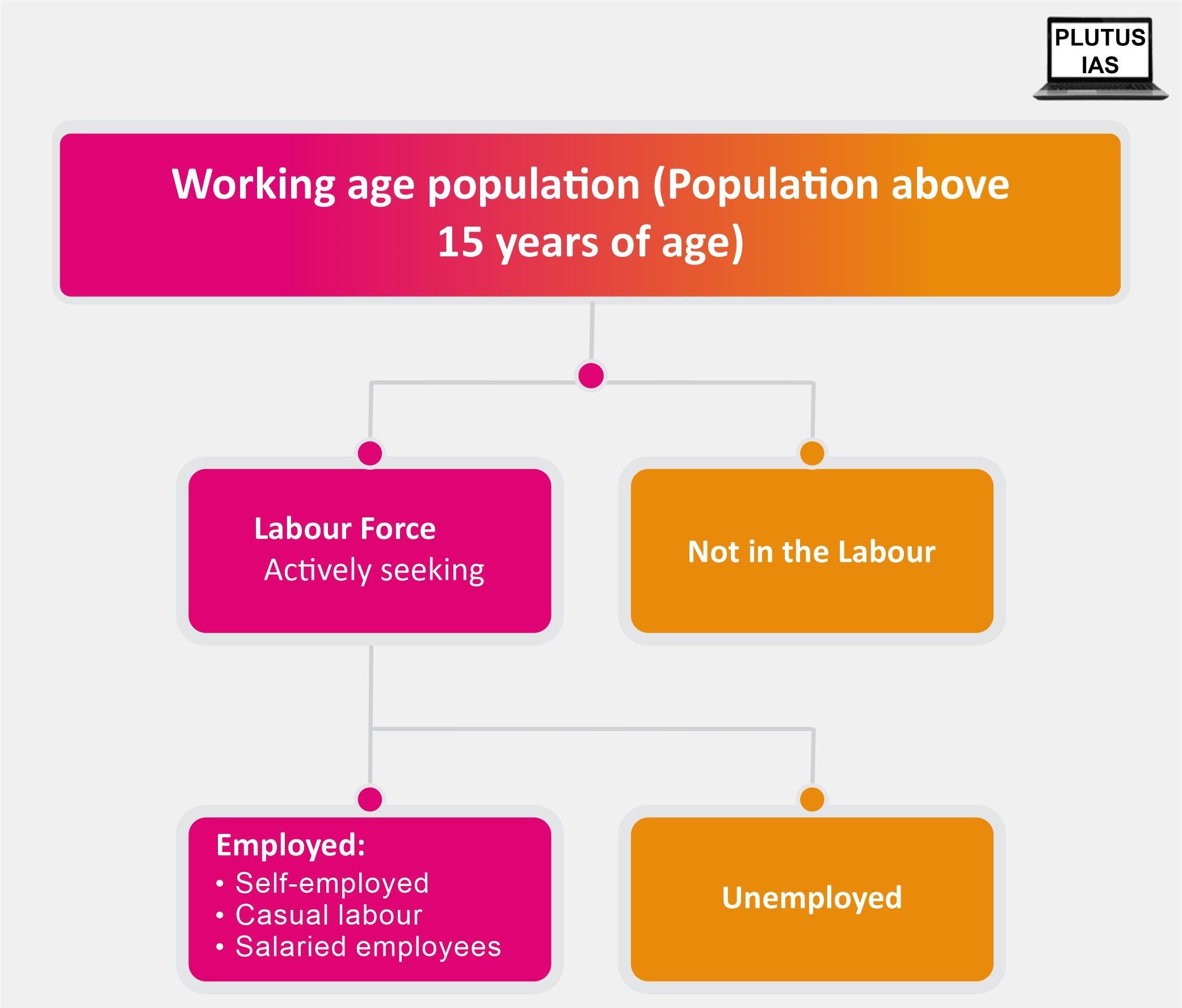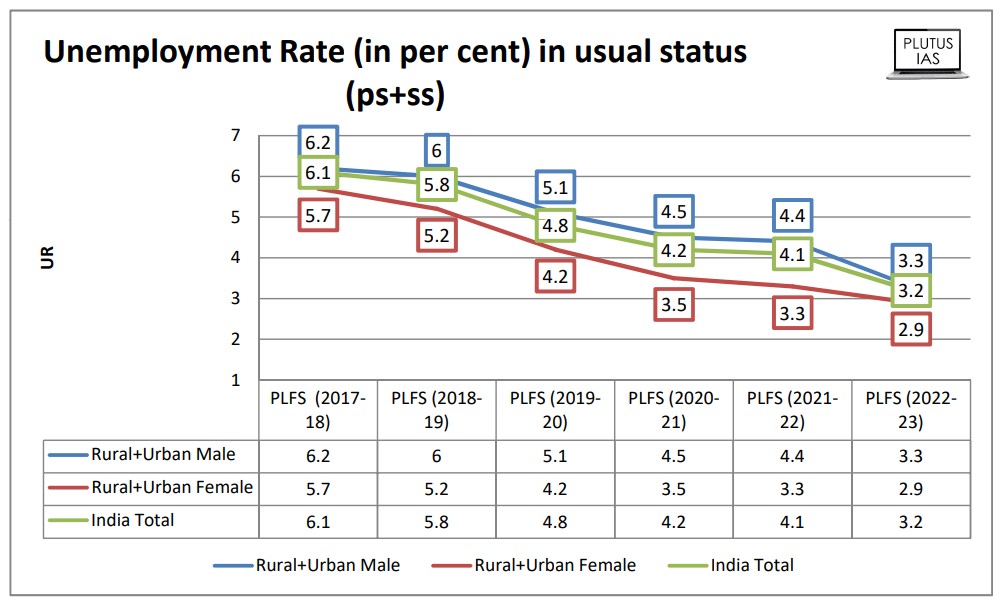18 Oct PLFS Report 2022-23
This article covers “Daily Current Affairs” and the topic details “PLFS Report 2022-23”. This topic has relevance in the “Economy” section of the UPSC CSE exam.
For Prelims:
What is PFLS?
What are different unemployment measurements?
For Mains:
GS3: Economy
Unemployment in India
Why in the news?
The National Sample Survey Office (NSSO) has published the sixth Annual Report, based on the Periodic Labour Force Survey conducted from July 2022 to June 2023.
About Periodic Labour Force Survey (PLFS)
- The National Sample Survey Office (NSSO) started the Periodic Labour Force Survey (PLFS) in April 2017, recognising the importance of having more regular information about the labour force.
- The primary objectives of PLFS:
- To promptly estimate key employment and unemployment indicators (such as the Worker Population Ratio, Labour Force Participation Rate, and Unemployment Rate) every three months, specifically for urban areas, using the ‘Current Weekly Status’ (CWS) methodology.
- To estimate employment and unemployment indicators annually using the ‘Usual Status’ and CWS methodologies for rural and urban areas.
- Five Annual Reports have already been published starting from 2017.
Basic Concepts:
- Labor Force:
-
- The Labor Force includes individuals who are either employed or actively seeking employment.
- It consists of both the employed and the unemployed individuals within a population who are of working age and are available and willing to work.
- Unemployment Rate (UR):
-
- The Unemployment Rate is the percentage of the labour force that is unemployed and actively seeking employment.
- Worker Population Ratio (WPR):
-
- The Workforce Participation Rate measures the proportion of a country’s population employed or actively seeking employment.
- Labor Force Participation Rate (LFPR):
-
- The Labor Force Participation Rate is the percentage of the population in the labour force.

- Usual Principal Status (PS):
-
- This method looks at a person’s primary activity 365 days before the survey date.
- For example, if someone has been employed for more than six months, they are considered employed.
- Usual Principal and Subsidiary Status (PS+SS):
-
- This method is more comprehensive than Usual Principal Status because it considers an individual’s activity status during the non-majority time.
- Under this method, anyone who has worked for at least 30 days during the reference year is classified as employed.
- Current Weekly Status (CWS):
-
- This method focuses on an individual’s activity status during the week just before the survey date.
- Those who didn’t have any gainful employment even for one hour during that week are classified as unemployed.
Highlights of the PFLS 22-23 Report:
- Labour force participation rate: 42.4% (India)
| LFPR (all ages) | Rural | Urban |
| Male | 55.5% | 58.3% |
| Female | 30.5% | 20.2% |
- Unemployment Rate (UR): 3.2% (India)
| UR (all ages) | Rural | Urban |
| Male | 2.8% | 4.7% |
| Female | 1.8% | 7.5% |
- Worker Population Ratio (WPR): 41.1% (India)
| WPR (all ages) | Rural | Urban |
| Male | 54.0% | 55.6% |
| Female | 30.0% | 18.7% |
- Status in Employment Among Workers:
| In Usual Status (ps+ss) | Rural | Urban |
| Male (Self-employed) | 58.8% | 39.4% |
| Female (Self-employed) | 71.0% | 40.4% |
| Male (Regular wage/salaried employees) | 14.3% | 47.1% |
| Female (Regular wage/salaried employees) | 8.0% | 50.8% |
| Male (Casual labor) | 26.8% | 13.6% |
| Female (Casual labor) | 21.0% | 8.9% |
- Unemployment Rate over the years:

Download plutus ias current affairs eng med 18th Oct 2023
Q1. With reference to the Periodic Labour Force Survey (PLFS), consider the following statements:
- The Labour Bureau, an attached office of the Ministry of Labour, publishes the PFLS.
- It estimates key employment and unemployment indicators for both Urban and Rural India every month.
- It uses both Current Weekly Status and Usual Status methodology for measuring employment.
Which of the statements given above is/are correct?
(a) 1 and 2 only
(b) 2 and 3 only
(c) 3 only
(d) None
Q2. Consider the following:
Methodology – Reference Period
- Current Weekly Status – 7 days
- Usual Principal Status – 365 days
- Usual Subsidiary Status – 30 days
How many of the abovementioned pairs are correct ?
(a) Only one
(b) Only two
(c) All three
(d) None
Q3. Discuss the various methodologies employed in measuring unemployment and highlight their significance in guiding government policies to address unemployment challenges.




No Comments